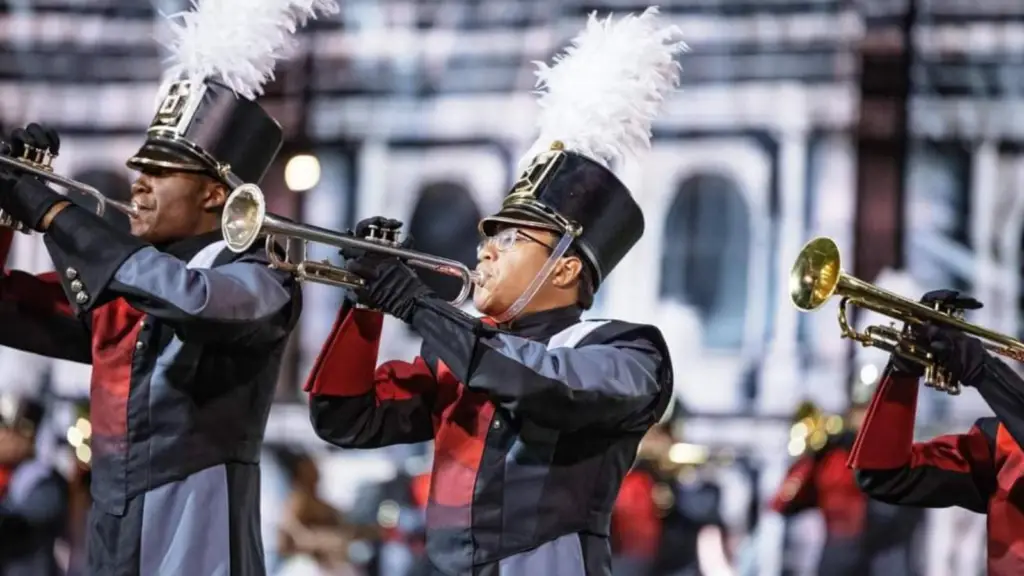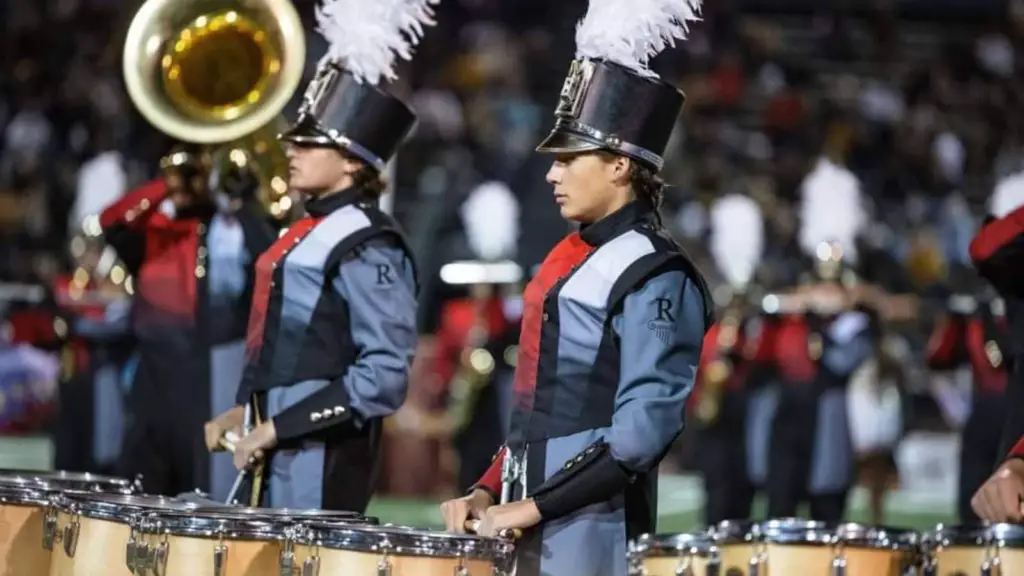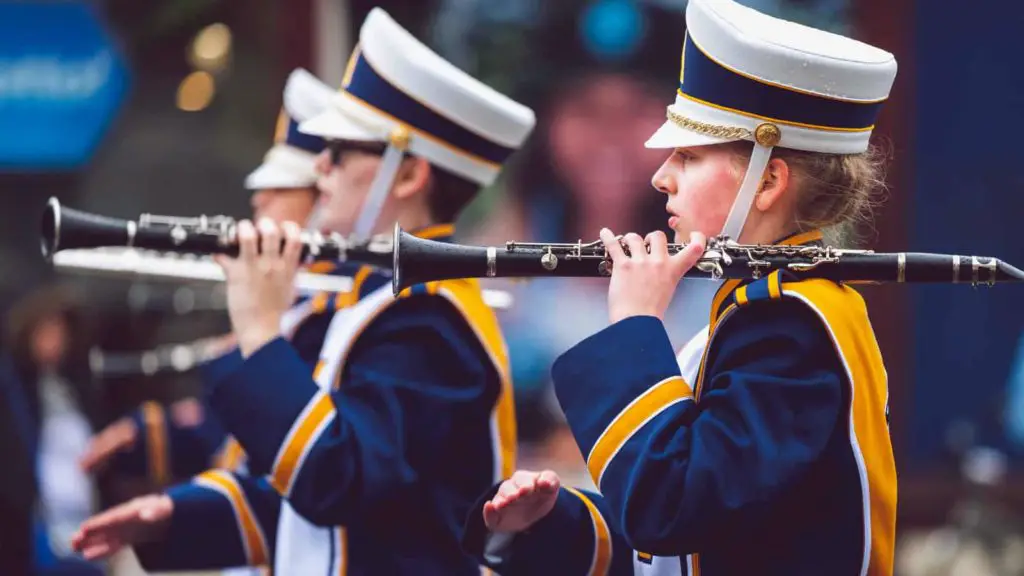On game day at Ohio State University, the Marching band takes 228 instruments onto the field. At Texas A&M, their instrumentalists showcase approximately 400. These performances, which typically look and sound very complex, may leave you wondering how many different instruments are actually in a Marching band.
Although the average size of a college Marching band can range from 220 members to more than 400, there are typically only 10-13 different types of instruments on the field at a time. These instruments are members of either the percussion, woodwind, or brass families.

In this article, we will explore 21 different types of instruments in a typical Marching band by looking at the different sections these instruments are part of.
What instrument sections make up a marching band?
Looking at the different sections that make up a Marching band provides a better understanding of what each instrument contributes to. The three sections we’ve outlined below are the Drumline, the Winds, and the Brass.
The Brass Section – Hornline
In a Marching band, the Hornline or brass section is the section made up of mostly brass horns. As the largest section in the band, these shiny instruments are heard the loudest, producing an epic, full sound when played in unison. Within this section, different instruments make up the soprano, alto, and bass lines.

- Trombone. Due to the low tone of the trombone, this instrument is considered part of the low brass family. Like all horns, the timbre of the sound produced depends on the vibrations of air going through the instrument.
When changing notes on a trombone, you can either change the vibrations using your diaphragm or you can adjust the slide in and out. The further out the slide is, the lower the pitch. - Alto & Tenor Saxophone. Despite its shiny appearance, the saxophone is actually a woodwind instrument because it has a reed. However, this smooth-sounding instrument is made of metal, classifying it as a brass woodwind.
For marching, the alto saxophone is preferred due to its lightness. The alto sax is slightly smaller than its tenor counterpart, with the former having a higher pitch. - Trumpet. The lightest instrument in the hornline, the trumpet is the soprano voice of the Marching band. The beauty of the trumpet lies in its ability to be both loud and lyrical. The sound of this brass horn can resonate loudly while producing lovely melodies. Combined with low brass instruments, the trumpet can also help create beautiful harmonies.
- Mellophone. The mellophone is practically a combination of the trumpet and french horn. Like a french horn, this instrument is played in key F. The fingerings of a mellophone are the same as a trumpet. In terms of sound, the bell of this instrument is quite large, emitting a low, rich tone when played.
- Euphonium or Baritone. Typically used in drum and bugle corps, the euphonium produces a mellow, deep tone. The fingering on the euphonium allows you to play more technical pieces, making it more melodic than other low brass instruments such as the Sousaphone.
As a result, this instrument can both contribute to harmonies as well as just play solo. - Sousaphone. While the trumpet is the soprano voice of the band, the sousaphone is the alto.
The lowest-pitched instrument in the brass family, the sousaphone wraps around your body and contributes to the bassline of a musical number. This instrument, which is a type of tuba, is one of the largest in the brass family.
The Drumline
The Drumline is responsible for keeping the rhythm of the band in check. Made up of several different instruments, the Drumline is split up into two parts: the Pit and the Battery.
The Pit, also known as the front ensemble, is composed of stationary percussion instruments. These instruments are much heavier than their on-field counterparts, requiring them to be parked at the front of the field so as to avoid awkwardly lugging them around in formation.
- Timpani. Timpani are large kettledrums. Aside from maintaining the beat for the rest of the Marching band, the pitch of this instrument can be adjusted. Additionally, depending on the softness of the mallet you use, the sound of the timpani can vary from warm to sharp.
- Marimba. A marimba looks very similar to a xylophone except larger. Made up of wooden keys, sound is produced by hitting a note with a mallet. Once a note is hit, tubes called resonators, which are underneath the marimba, project the sound from the instrument to our ears. You can play a marimba with up to six mallets at a time.
- Gong. Originating from Southeast Asia, a gong is a metal disk that resounds upon being struck by a mallet. Gong mallets typically have heavier felt heads than normal mallets, which helps to produce more reverberation.
- Xylophone. Likely the most familiar name in this list, the xylophone is made up of wooden keys that are played with a mallet. The layout, which consists of a repeated 12-note pattern, is very similar to that of a piano.

The Battery is part of the marching ensemble. Unlike the heavy percussion instruments in the Pit, members of the Battery are able to carry their instruments as they march with the rest of the band.
- Snare drums. A snare drum is just as popular among rock n’ roll bands as it is among Marching bands. This smaller percussion instrument produces a sharp, crisp pop once hit with a drumstick. The snare is one of the most dominant instruments on the field as they keep the melody in check for the rest of the band. In a drumline, the snare is often the first instrument you’ll hear.
- Bass Drums. Much larger than the snare drum, the bass drum produces a low tone when struck with a mallet. Based on how you hit it, the sound of this drum can either sound staccato or legato.
- Tenor Drums. Marching tenor drums usually include 4-6 drums in a set. Also known as “tom-toms,” these drums are heavy and can weigh up to 32 lbs depending on how many are in a set. With multiple surfaces to play, this instrument requires the player to conduct lots of lateral movement.
- Cymbals. are two circular, metal discs that when struck together, produce an epic, reverberating
sound. Depending on how you use them, the noise the pair creates can range from a ‘sizzle’ to a loud crash. - Marching Bells. Like a xylophone, marching bells are tuned percussion instruments. Sound is emitted by hitting the keys with a hard mallet. This produces a bright, crisp chime.
As for its scale, the smaller notes produce higher pitches whereas the bigger notes produce lower pitches. Unlike the bell lyre, marching bells are played horizontally and are held up a carrier. - Bell Lyre. Although this instrument sounds very similar to the marching bells, the bell lyre is handheld and played upright. With its curled ends, the bell lyre slightly resembles a harp.
Top Tip: Learn all there is to know about Marching Band Bells and Bell Lyre in this article. Marching Band Bells (Your Complete Guide!).

The Winds
The Winds, or woodwinds, are the section of a Marching band that contribute to the voice and melody of a performance.
Of all the instruments in a Marching band, the ones in this section are often the lightest in weight and therefore the most portable. Although woodwinds aren’t as loud as brass horns, they add more timbre and texture to the final musical piece.
- Flutes. A flute is one of the highest-pitched instruments in the woodwind family. It is also the only one that doesn’t have a reed.
Sound is produced by blowing through the embouchure, the hole at the tip of the instrument. Pressing the holes and keys along the flute affects the vibration of air going through the body of the instrument, changing the pitch and allowing you to play notes. - Piccolo. Playing one octave higher than the flute and at half the size, the piccolo is both the smallest and highest-pitched woodwind. The piccolo possesses three different registers or ranges of notes. These are the low, middle, and high registers.
The low register sounds soft and harmonious whereas the high register has a sharp edge, piercing through the sounds of a full band with its distinct high pitch. The sound of the middle register lies in between these two. - Clarinet. Like most woodwinds, the clarinet produces sound by vibrating the single wooden reed at the mouthpiece of the instrument.
The clarinet’s range in pitch is one of the largest in the woodwind family. Whereas the lower notes sound dark and honeyed, the higher notes are vivid and bright.
Top Tip: You may notice that the oboe and bassoon are not included in a Marching band’s woodwind section. Unlike the single-reed instruments listed above, these two instruments are both played using a double reed. This special reed is much more delicate, making it less than ideal for marching and playing outside.
Next time you see a Marching band perform, keep an eye out for any of the 21 instruments listed above. If you listen closely, you might be able to distinguish the melody of a trumpet or the bass of a timpani.
Check out these other articles all about Marching Band
21 Marching Band Show Ideas– Top Music Tips
Marching Band Positions & Organization – Top Music Tips
We hope this article has been helpful and informative for you in your musical journey. Please let us know if there is anything that we could add or change to make this article a better resource for our readers.
Please e-mail us at: [email protected] to let us know how we are doing!
Disclaimer: This post may contain affiliate links. We only recommend high-quality products that are used and recommended by real musicians. If you use these links to buy something we earn a small commission.
